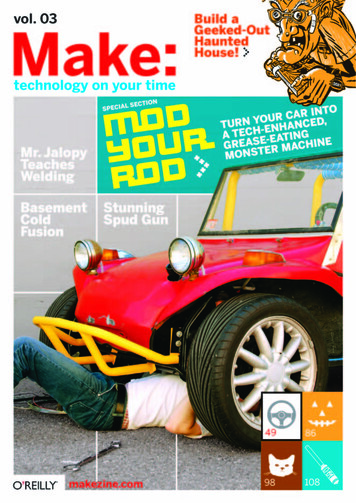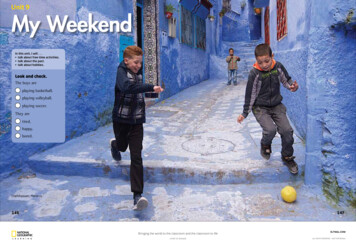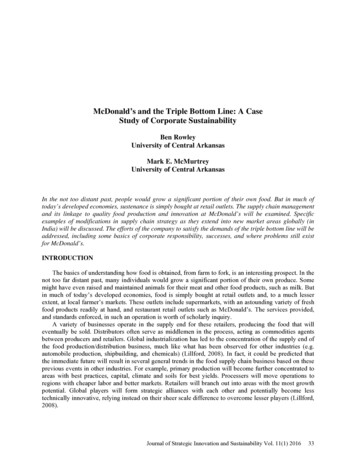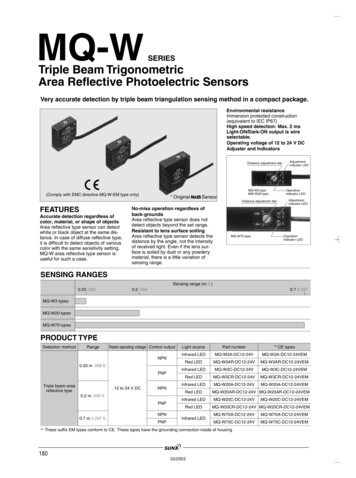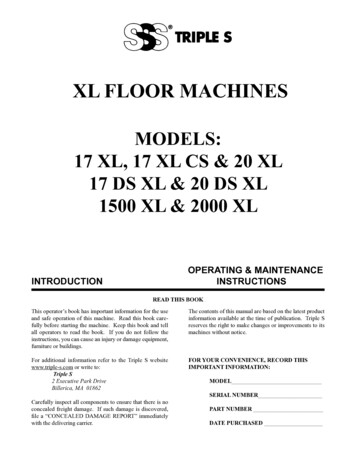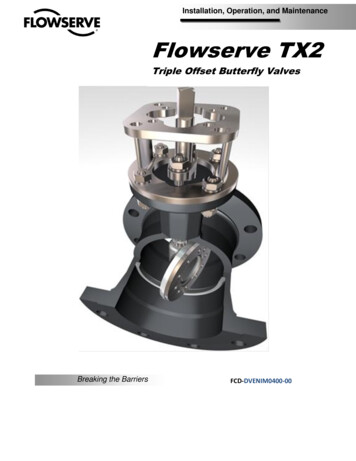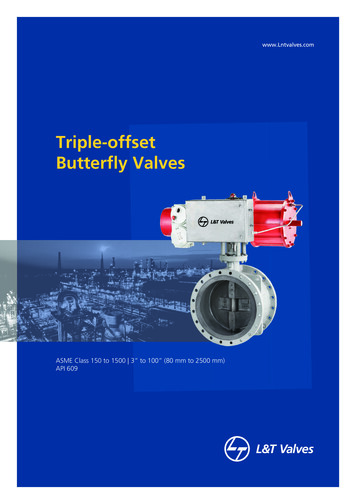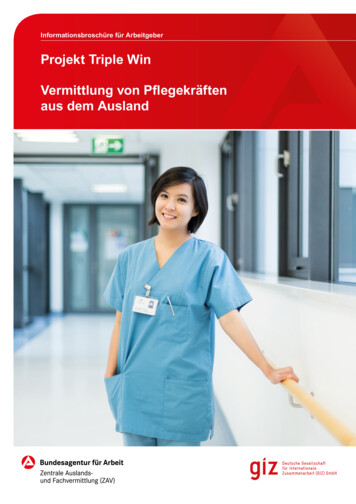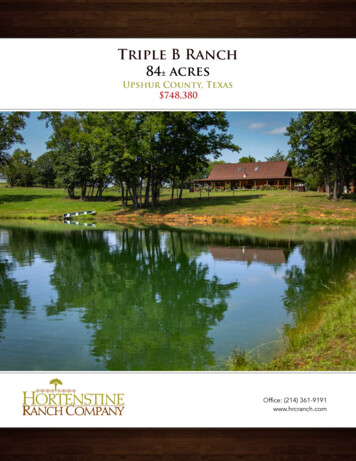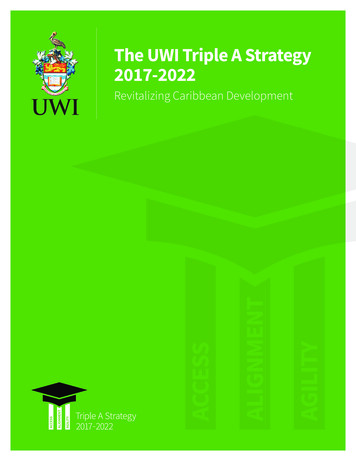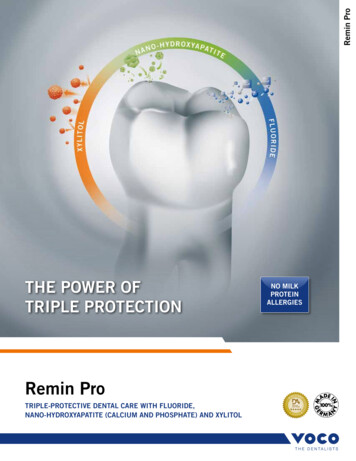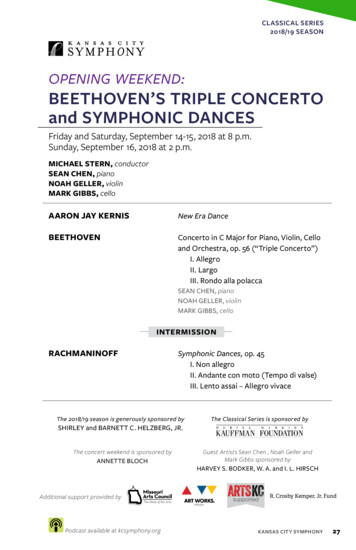
Transcription
CLASSICAL SERIES2018/19 SEASONOPENING WEEKEND:BEETHOVEN’S TRIPLE CONCERTOand SYMPHONIC DANCESFriday and Saturday, September 14-15, 2018 at 8 p.m.Sunday, September 16, 2018 at 2 p.m.MICHAEL STERN, conductorSEAN CHEN, pianoNOAH GELLER, violinMARK GIBBS, celloAARON JAY KERNISNew Era DanceBEETHOVENConcerto in C Major for Piano, Violin, Celloand Orchestra, op. 56 (“Triple Concerto”)I. AllegroII. LargoIII. Rondo alla polaccaSEAN CHEN, pianoNOAH GELLER, violinMARK GIBBS, celloINTERMISSIONRACHMANINOFFSymphonic Dances, op. 45I. Non allegroII. Andante con moto (Tempo di valse)III. Lento assai – Allegro vivaceThe 2018/19 season is generously sponsored byThe Classical Series is sponsored bySHIRLEY and BARNETT C. HELZBERG, JR.The concert weekend is sponsored byANNETTE BLOCHAdditional support provided byPodcast available at kcsymphony.orgGuest Artists Sean Chen , Noah Geller andMark Gibbs sponsored byHARVEY S. BODKER, W. A. and I. L. HIRSCHR. Crosby Kemper, Jr. FundKANSAS CITY SYMPHONY27
Kansas City SymphonyPROGRAM NOTES By Ken MeltzerAARON JAY KERNIS (b. 1960)New Era Dance (1992)6 minutesPiccolo, 2 flutes, 2 oboes, 2 clarinets, E-flat clarinet, bassclarinet, 2 bassoons, 4 horns, 3 trumpets, 2 trombones, basstrombone, tuba, timpani, 4 percussion, piano, synthesizerand strings.The New York Philharmonic (for its150th anniversary) and the BaltimoreSymphony Orchestra jointly commissionedNew Era Dance by American composer AaronJay Kernis. In his brief program notes,Kernis explains:New Era Dance is dedicated and writtenin celebration of a new era of leadershipin this country.”at the New York PhilharmonicThe vibrant orchestral[Kurt Masur began his tenure as thework is a brilliantorchestra’s Music Director in 1991synthesis of popular– Ed.], in anticipation of the newAmerican dancemillennium to come in the year 2000, instyles and traditions.hope for a time of imperative politicaland social change in this country.In New Era Dance, Kernis invokes a wide range of American dancetraditions and styles to create a brilliant orchestral opener.American composerAaron Jay Kerniswrote his NewEra Dance “inhope for a time ofimperative politicaland social changeRECOMMENDED RECORDINGAaron Jay Kernis: New Era DanceBaltimore Symphony / David Zinman, conductorLabel: Decca Catalog # 444454282018/19 Seasonkcsymphony.org
Kansas City SymphonyPROGRAM NOTES By Ken MeltzerLUDWIG VAN BEETHOVEN (1770-1827)Concerto in C Major for Piano, Violin, Cello andOrchestra, op. 56 (“Triple Concerto”) (1804)34 minutesSolo piano, violin and cello, flute, 2 oboes, 2 clarinets,2 bassoons, 2 horns, 2 trumpets, timpani and strings.By the turn of the 18th century, Ludwigvan Beethoven had firmly established himselfBeethoven wrote theas one of Vienna’s most prominent musicians“Triple Concerto” at— a virtuoso pianist and composer of the firsta time when he wasrank. It appeared as if nothing could standconfronting the onsetin the way of his continued rise to greatness,of deafness that wouldbut then tragedy struck. In 1800, Beethoven,plague him for thenot yet 30, began to realize his hearing wasremainder of his life.deteriorating. He sensed that he would soonStill, there is no senselose his hearing altogether.of despair in thisThe irony was not lost on Beethoven.genial work, full ofSoon, he would be a pianist unable to performlyricism as well asin public, and a composer unable to hear hisvirtuoso opportunitiesfor the three soloists.own musical creations. This turn of eventsengendered a supreme crisis in his life. OnOctober 6, 1802, he penned the immortal letter to his brothers knownas the “Heiligenstadt Testament.” Beethoven confessed that the onsetof his deafness almost made me despair, and I was on the point of puttingan end to my life — The only thing that held me back was myart. For indeed it seemed to me impossible to leave this worldbefore I had produced all the works I felt the urge to compose;and thus I have dragged on this miserable existence — a trulymiserable existence.Indeed, Beethoven responded to his adversity by composing at afurious pace. Masterpieces from the first decade of the 19th centuryinclude his second through sixth symphonies, the “Razumovsky” stringquartets, the “Waldstein” and “Appassionata” piano sonatas, and theKANSAS CITY SYMPHONY29
Kansas City SymphonyPROGRAM NOTES By Ken Meltzercomposer’s only opera, Fidelio. The “Triple Concerto” belongs to thatsame fruitful period. Beethoven began composition of the concerto inlate 1803, completing the work in the summer of 1804.He scored the “Triple Concerto” for a trio of soloists (piano, violinand cello) and orchestra. While composed around the same time as hispathbreaking “Eroica” Symphony, the Concerto presents a far moregenial and lyrical side of Beethoven’s craft. The opening Allegro is themost expansive of the work’s three movements. A hushed Largo leads,without pause, to the finale, which is a rondo based on the sparklingPolish dance, the polonaise.RECOMMENDED RECORDINGBeethoven: “Triple Concerto”Eugene Istomin, piano; Isaac Stern, violin; Leonard Rose, celloPhiladelphia Orchestra / Eugene Ormandy, conductorLabel: Sony Catalog # 826772
The Kansas City Symphony Guild PresentsThe Kansas City Symphony Guild PresentsHomes of Note 2018Note2018FeaturingHomeshomes at TheofNationalGolf Clubof Kansas CityFeaturing homes at The National Golf Club of Kansas CityFor tickets and more information, visit www.kcsymphonyguild.orgFor ticketsinformation, visitwww.kcsymphonyguild.org 20andINmoreADVANCE 25AT THE DOORproceedsbenefit 20AllINADVANCEAll proceeds benefit 25 AT THE DOOR
Kansas City SymphonyPROGRAM NOTES By Ken MeltzerSERGEI RACHMANINOFF (1873-1943)Symphonic Dances, op. 45 (1940)35 minutesPiccolo, 2 flutes, 2 oboes, English horn, 2 clarinets, bassclarinet, alto saxophone, 2 bassoons, contrabassoon,4 horns, 3 trumpets, 3 trombones, tuba, timpani, bass drum,chimes, cymbals, side drum, orchestra bells, tam-tam,tambourine, triangle, xylophone, harp, piano and strings.In describingSymphonic Dances,his final composition,Rachmaninoffcommented, “I don’tknow how it happened,it must have been mylast spark.”The work, in threemovements, featuresthemes Rachmaninoffemployed throughouthis career, includingthe ancient plainchant“Dies irae” (Day ofwrath), which makes adramatic appearancein the finale.On June 30, 1938, Russianchoreographer Michel Fokine presentedthe world premiere of Paganini, his balletadaptation of Sergei Rachmaninoff’s workfor solo piano and orchestra, Rhapsodyon a Theme of Paganini, op. 43 (1934).Rachmaninoff hoped to attend the Londonperformance but an injury sustained after afall made that impossible.Rachmaninoff soon regained hishealth, and the composer/pianist resumed ademanding European and American concerttour. Finally, in spring 1940, Rachmaninoffwas able to enjoy a period of rest. Hetraveled to Orchard Point, an estate nearHuntington, New York, on Long Island.There, Rachmaninoff composed his finalwork, Symphonic Dances.It appears that Rachmaninoff first conceived Symphonic Dancesas another potential ballet subject for Fokine. Rachmaninofforiginally entitled the work Fantastic Dances, with the three movementsrepresenting “Midday,” “Twilight” and “Midnight.” Rachmaninofflater discarded these titles and designated the various movementssimply by their tempo markings. Prior to orchestrating the work,Rachmaninoff played excerpts of the dances on the piano forFokine. However, the choreographer’s death in 1942 prevented any322018/19 Seasonkcsymphony.org
Kansas City SymphonyPROGRAM NOTES By Ken Meltzercontemplated ballet from becoming a reality.Rachmaninoff initially scored Symphonic Dances for two pianosbefore completing the orchestration in the autumn of 1940. Hededicated the work to conductor Eugene Ormandy and thePhiladelphia Orchestra, who gave the premiere on January 3, 1941.The initial critical reception was not enthusiastic. However, in time,Symphonic Dances became widely admired as the composer’s finestorchestral achievement. Rachmaninoff was rather surprised by hisaccomplishment, observing, “I don’t know how it happened, it musthave been my last spark.”Rachmaninoff died two years after the premiere of SymphonicDances and never composed another work. While it is not clearRachmaninoff intended it to be his final composition, the piece has adecidedly valedictory character. Symphonic Dances features quotationsof earlier Rachmaninoff compositions as well as the “Dies irae”(Day of wrath) chant — a recurring leitmotif in his music. Further,the masterful orchestration, captivating melodies and brilliantjuxtaposition of dramatic and lyric elements are all trademarks ofRachmaninoff’s art.Symphonic Dances is in three movements. The first opens withvarious winds, over furtive string accompaniment, introducingthe movement’s principal descending “short-short-long” rhythmicfigure. An expansive, lyrical interlude features a solo alto saxophone,the only time Rachmaninoff included this instrument (for this, thecomposer sought the advice of a friend, Broadway orchestratorRobert Russell Bennett). The second movement is an extended andbrilliantly scored waltz. The finale is a fantasia on the “Dies irae”plainchant. As in the opening movement, the finale offers a lengthycontrasting central episode in slow tempo before the “Dies irae”returns in the propulsive conclusion.RECOMMENDED RECORDINGRachmaninoff: Symphonic DancesMoscow Philharmonic / Kiril Kondrashin, conductorLabel: Urania Records Catalog # 303KANSAS CITY SYMPHONY33
Kansas City SymphonyAbout SEAN CHEN, pianoTWENTY-NINE-YEAR-OLD AMERICAN PIANIST SEAN CHEN IShailed as a charismatic rising star with “an exceptional ability to connect withan audience combined with an easy virtuosity” (Huffington Post). As recipient ofthe DeHaan Classical Fellowship, winner of the 2013 American Pianists Awardsand third-prize winner at the 2013 Van CliburnInternational Piano Competition, he continuesto earn accolades for “alluring, colorfully shadedrenditions” (New York Times) and “genuinelysensitive” playing (LA Times). He was named a2015 fellow by the prestigious Leonore AnnenbergFellowship Fund for the Performing Arts.Chen has performed with many prominentorchestras, including the Fort Worth, Hartford,Hudson Valley, Indianapolis, Knoxville, LouisianaPhilharmonic, Milwaukee, North Carolina,Pasadena, Phoenix, Plano, San Diego, SantaFe, Tucson and New West symphony orchestras, as well as the Philadelphia,Indianapolis and South Bay chamber orchestras, collaborating with such esteemedconductors as Leonard Slatkin, Gerard Schwarz, Nicholas McGegan, MiguelHarth-Bedoya, Marcelo Lehninger, Nir Kabaretti, James Judd, George Hanson,Hector Guzman and Boris Brott.As a result of his relationships with both orchestral musicians and audiencemembers, Chen has made return appearances with several orchestras, includingthe San Diego Symphony, Santa Fe Symphony, Columbus Indiana Philharmonic,Indianapolis Chamber Orchestra, Carmel Symphony Orchestra and SunriverMusic Festival Orchestra.His CD releases include “La Valse,” a solo recording on the Steinway labelhailed for “penetrating artistic intellect” (Audiophile Audition), a live recordingfrom the Cliburn Competition released by Harmonia Mundi and praised for his“ravishing tone and cogently contoured lines” (Gramophone), and an album ofMichael Williams’ solo piano works on the Parma label. Chen also has contributedto the catalog of Steinway’s new Spirio system and is a Steinway Artist.Born in Florida, Chen grew up in Oak Park, California. He received hisartist diploma in 2014 from the Yale School of Music as a George W. Miles Fellow.His teachers include Hung-Kuan Chen, Tema Blackstone, Edward Francis,Jerome Lowenthal and Matti Raekallio. He currently lives in Kansas City,Missouri, and is an artist-in-residence at the University of Missouri-Kansas CityConservatory of Music and Dance. His wife Betty is a violinist with the KansasCity Symphony. When not at the piano, he enjoys tinkering with computers.342018/19 Seasonkcsymphony.org
Kansas City SymphonyAbout NOAH GELLER, violinVIOLINIST NOAH GELLER HAS PERFORMED EXTENSIVELYthroughout the United States and abroad. Prior to his appointment as SeattleSymphony concertmaster in 2018, he served as Kansas City Symphonyconcertmaster from 2012 to 2018 where he appeared frequently as a soloist. Hemade his solo recording debut on the KansasCity Symphony’s Reference Recordings albumfeaturing music by Saint-Saëns. Additionally,Geller worked as adjunct associate professor ofviolin at the University of Missouri-Kansas CityConservatory of Music and Dance.Geller began his professional career in thefirst violin section of the Philadelphia Orchestrain 2007 while still pursuing his master’s degree.He served as acting assistant concertmaster ofthe Philadelphia Orchestra for the 2010 and2011 seasons. Geller has performed as guestconcertmaster with the orchestras of Pittsburgh, Houston and Beijing (ChinaNational Symphony) and appears regularly with the dynamic, spirited andconductorless East Coast Chamber Orchestra.An active chamber musician, Geller has performed at the Marlboro,Kingston, Saratoga, Heartland and Skaneateles festivals, and has appeared onthe Lyon and Healy (Chicago), Philadelphia Museum of Art and Lyric ChamberMusic Society (New York) series, among others. He is an original member ofShir Ami, an ensemble dedicated to the music of composers whose lives wereadversely affected by the Holocaust. Geller has organized and presentedconcerts by Shir Ami for the Kansas City community, garnering remarkablesupport and enthusiasm.Geller grew up in the Chicago area, studying privately with JenniferCappelli. He received his bachelor’s and master’s degrees from the JuilliardSchool where he studied with Hyo Kang, Donald Weilerstein and Cho-LiangLin. When not on stage, Geller enjoys spending time with his wife, percussionistMari Yoshinaga, and their dog, Monkey. He performs on a violin made byAndreas Postacchini c.
AARON JAY KERNIS New Era Dance BEETHOVEN Concerto in C Major for Piano, Violin, Cello and Orchestra, op. 56 (“Triple Concerto”) I. Allegro II. Largo III. Rondo alla polacca SEAN CHEN, piano NOAH GELLER, violin MARK GIBBS, cello INTERMISSION RACHMANINOFF Symphonic Dances, op. 45 I. Non allegro II. Andante con moto (Tempo di valse) III. Lento assai – Allegro vivace OPENING
